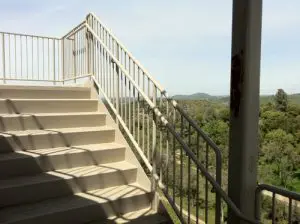
A nonstructural component with an Ip > 1.0 should only be in a building with an Ie > 1, right?
The importance factors for buildings were established before nonstructural component bracing became a subject of particular interest in the code. Initially, the importance factor of the building also established the importance factor for the components in that building. In the early 1990s, separate importance factors were established for components based on the components’ importance to life safety. It is therefore possible to have components with an importance factor Ip of 1.5 (e.g., egress stairs) in a building with an Ie of 1.0 (see ASCE 7-10 Section 13.1.3). The importance factor of a structure does not (and probably should not) dictate the value of the importance factor for the components in that structure, except in the case of Risk Category IV facilities, and then only if the component is necessary to the continued operation of the facility (see ASCE 7-10 Section 13.1.3 subparagraph 3).
A resource supporting the assertions in the above paragraph is the 2009 NEHRP Provisions Commentary and ASCE 7-10 Expanded Seismic Commentary (see 3rd Printing of ASCE 7-10) Section 13.1.3 which includes the following information:
Components with importance factors greater than 1.0 are expected to remain in place, sustain limited damage, and, when necessary, function following an earthquake (see Section C13.2.2). These components can be located in structures that are not assigned to Risk Category IV. For example, fire sprinkler piping systems have an importance factor, Ip, of 1.5 in all structures since these essential systems should function following an earthquake. Egress stairways are assigned an Ip of 1.5 as well, although in many cases the design of these stairways is dictated by differential displacements, not inertial force demands.
The component importance factor is intended to represent the greater of the life-safety importance of the component and the hazard-exposure importance of the structure. It indirectly influences the survivability of the component via required design forces and displacement levels as well as component attachments and detailing. While this approach provides some degree of confidence in the seismic performance of a component, it may not be sufficient in all cases. For example, individual ceiling tiles may fall from a ceiling grid that has been designed for larger forces. This may not represent a serious falling hazard if the ceiling tiles are made of lightweight materials, but it may lead to blockage of critical egress paths or disruption of the facility function. When higher levels of confidence in performance are required, the component is classified as a designated seismic system (Section 11.2), and, in certain cases, seismic qualification of the component or system is necessary. Seismic qualification approaches are provided in Sections 13.2.5 and 13.2.6. In addition, seismic qualification approaches presently in use by the Department of Energy (DOE) can be applied.
Risk Category IV structures are intended to be functional following a design earthquake; critical nonstructural components and equipment in such structures are designed with Ip equal to 1.5. This requirement applies to most components and equipment since damage to vulnerable unbraced systems or equipment may disrupt operations following an earthquake even if they are not directly classified as essential to life safety. The nonessential/nonhazardous components themselves are not assessed, and requirements focus solely on the supports and attachments.